📞+86 153 7530 2641 📧 hongjing.Wang@feichuncables.com

(N)3GRDC5G-J/O Flexible Round Festoon Cables: Superior Solutions for High Mechanical Stress Applications
Discover (N)3GRDC5G-J/O flexible round festoon cables designed for trolley systems, drag chains, and conveyor facilities. UV-resistant, oil-resistant, and RoHS-compliant industrial cables with exceptional durability for demanding Australian industrial applications.
hongjing.Wang@Feichun
8/1/20257 min read

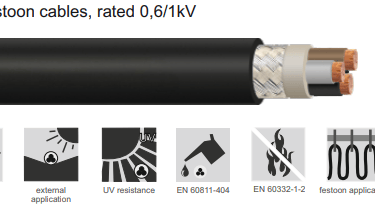
Introduction
In the demanding world of industrial automation and material handling, the reliability of electrical connections can make or break operational efficiency. The (N)3GRDC5G-J/O flexible round festoon cables represent a pinnacle of engineering excellence, specifically designed to withstand the rigorous mechanical stresses encountered in modern industrial environments. These specialised cables serve as the lifeline for power and control systems in applications where conventional cables would fail, providing uninterrupted electrical connectivity in the most challenging conditions.
The significance of reliable cables for high mechanical stress applications cannot be overstated. In industries ranging from mining and manufacturing to logistics and construction, equipment operates continuously under extreme conditions. Standard cables simply cannot cope with the constant flexing, stretching, and environmental exposure that characterise these demanding applications. This is where the (N)3GRDC5G-J/O festoon cables excel, offering a robust solution that maintains electrical integrity whilst withstanding the physical punishment of industrial operations.
Rated at 0.6/1kV, these flexible round festoon cables are engineered to deliver consistent performance in environments where reliability is paramount. Their sophisticated design incorporates advanced materials and construction techniques that address the specific challenges faced by industrial operators, from extreme temperature variations to chemical exposure and mechanical stress.
Key Features of (N)3GRDC5G-J/O Festoon Cables
Design Specifications
The (N)3GRDC5G-J/O cables feature a meticulously engineered construction that begins with bare copper conductors manufactured to Class 5 specifications according to DIN EN/IEC 60228. These finely stranded conductors provide exceptional flexibility whilst maintaining excellent electrical conductivity, crucial for applications requiring frequent movement and positioning.
The insulation system employs HEPR (Hard Ethylene Propylene Rubber) compound conforming to IEC 60502-1 standards. This advanced insulation material offers superior electrical properties and enhanced durability compared to conventional PVC insulation. The colour coding follows DIN VDE 0293-308 specifications, with coloured cores up to 5 wires and numbered natural cores from 6 wires onwards, including optional green/yellow protective conductors for enhanced safety compliance.
The core arrangement features cores stranded in layers around a central element, optimising flexibility whilst maintaining structural integrity. The inner sheath utilises synthetic rubber compound type GM1b/EPDM according to DIN VDE 0207-21, filling interstices to provide additional protection and maintain cable geometry under stress.
A critical protective element is the tinned copper wire and synthetic thread braid screen, which provides electromagnetic shielding and mechanical protection. The outer sheath consists of heavy-duty rubber compound type 5GM5, conforming to DIN VDE 0207-21 specifications. This black outer sheath incorporates inkjet marking for easy identification and features exceptional resistance to UV radiation, ozone, and moisture.
Thermal and Mechanical Properties
The thermal performance of (N)3GRDC5G-J/O cables demonstrates their versatility across varied environmental conditions. For flexible operation, the cables maintain functionality from -30°C to 80°C, whilst fixed installations can operate from -40°C to 80°C. The maximum permissible conductor temperature reaches 90°C, with short-circuit conditions accommodated up to 250°C at the conductor.
Mechanically, these cables are engineered to withstand substantial stress. The maximum tensile load per conductor is rated at 15 N/mm², providing confidence in applications involving significant mechanical forces. The bending radius specifications are particularly noteworthy: fixed installations require a minimum bending radius of 4 times the outer diameter, whilst festoon applications require 5 times the outer diameter. This specification ensures cable longevity even under frequent bending cycles.
The reeling speed capability of up to 240 metres per minute makes these cables ideal for dynamic applications such as crane systems and automated material handling equipment. This specification demonstrates the cable's ability to maintain integrity during rapid deployment and retraction cycles.
Electrical Parameters
The electrical specifications of (N)3GRDC5G-J/O cables reflect their industrial-grade construction. With a rated voltage of 0.6/1kV (U0/U), these cables handle substantial electrical loads whilst maintaining safety margins. The maximum permissible operating voltage in AC systems reaches 0.7/1.2kV, providing additional headroom for voltage fluctuations common in industrial environments.
Quality assurance includes AC test voltage ratings of 2.5kV, ensuring reliable performance and safety compliance. These electrical parameters make the cables suitable for both power distribution and control applications in industrial settings.

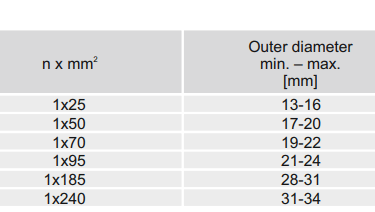
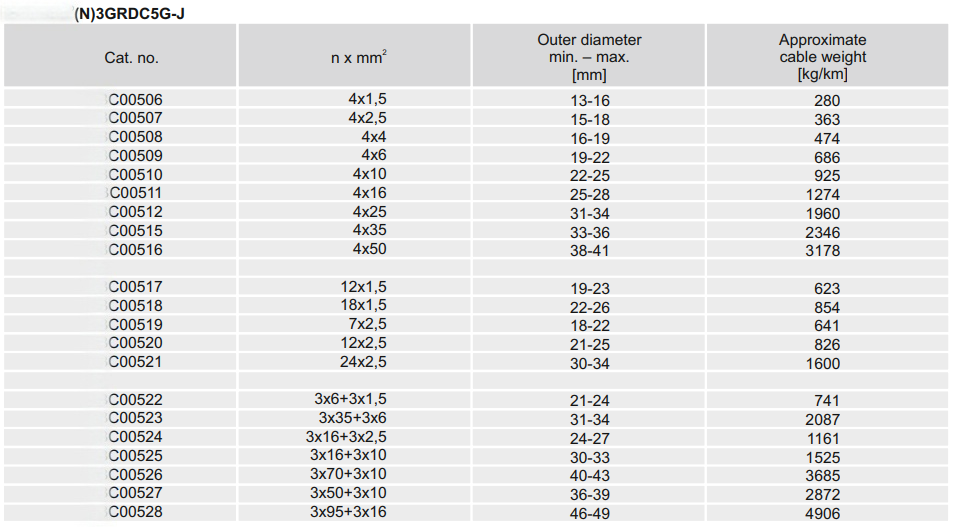

Applications of (N)3GRDC5G-J/O Cables
The versatility of (N)3GRDC5G-J/O cables extends across numerous industrial applications, each benefiting from their unique combination of flexibility, durability, and electrical performance. In trolley systems, these cables provide reliable power and control connections for overhead cranes, gantry systems, and automated guided vehicles. The cables' ability to withstand frequent bending in one direction makes them particularly suitable for these applications, where conventional cables would suffer premature failure.
Drag chain applications represent another primary use case, where cables must endure continuous flexing as they move through cable carriers. The (N)3GRDC5G-J/O design specifically addresses the challenges of drag chain environments, including torsional stress, acceleration forces, and confined spaces. The cables maintain their electrical properties and physical integrity throughout millions of flex cycles, ensuring uninterrupted operation of automated machinery.
Conveyor facilities benefit significantly from these specialised cables, particularly in systems requiring long cable runs and frequent repositioning. Mining conveyor systems, airport baggage handling, and manufacturing assembly lines all present demanding environments where cable reliability directly impacts operational efficiency. The outdoor capability of these cables extends their applicability to open-pit mining operations, port facilities, and construction sites.
The suitability for both indoor and outdoor environments opens additional application possibilities. Outdoor crane installations, mobile equipment, and temporary power systems all benefit from the weather resistance and UV protection built into the cable design. The resistance to ozone, moisture, and temperature extremes ensures consistent performance regardless of environmental conditions.
Compliance and Standards
Regulatory compliance represents a critical aspect of industrial cable selection, and (N)3GRDC5G-J/O cables meet stringent international standards. RoHS 2015/863/EU compliance ensures environmental responsibility by restricting hazardous substances, whilst LVD 2014/35/EU compliance guarantees electrical safety in low voltage applications. Additionally, CPR 305/2011 compliance addresses construction product requirements, ensuring suitability for building applications.
Fire behaviour testing according to DIN EN/IEC 60332-1-2 demonstrates the cables' performance under fire conditions, providing critical safety assurance for industrial installations. This testing ensures that the cables will not contribute to fire propagation, protecting both personnel and equipment.
Oil resistance testing per DIN EN/IEC 60811-404 confirms the cables' suitability for industrial environments where hydraulic fluids and lubricants are present. This resistance prevents cable degradation and maintains insulation integrity in contaminated environments, extending service life and reducing maintenance requirements.
The comprehensive compliance profile ensures that (N)3GRDC5G-J/O cables meet the demanding requirements of Australian industrial standards whilst providing confidence for international applications.


Benefits of Choosing (N)3GRDC5G-J/O Cables
The selection of (N)3GRDC5G-J/O cables delivers numerous operational advantages that translate directly into improved productivity and reduced maintenance costs. The exceptional durability under high mechanical stress ensures extended service life, reducing the frequency of cable replacements and associated downtime. This durability is particularly valuable in continuous operation environments where cable failure can result in significant production losses.
Versatility represents another key advantage, with the cables' ability to perform across diverse applications reducing inventory requirements and simplifying procurement processes. A single cable type can serve multiple applications within a facility, streamlining maintenance procedures and spare parts management.
The long-term reliability in harsh environments provides peace of mind for facility managers and maintenance teams. The combination of environmental resistance, mechanical durability, and electrical integrity ensures consistent performance throughout the cable's service life. This reliability translates into predictable maintenance schedules and reduced emergency repair situations.
Cost-effectiveness emerges from the extended service life and reduced maintenance requirements. Whilst the initial investment may be higher than standard cables, the total cost of ownership proves favourable when considering replacement frequency, labour costs, and production disruptions avoided.
The professional installation and maintenance characteristics of these cables contribute to their overall value proposition. The flexible construction facilitates installation in confined spaces, whilst the robust design minimises handling damage during installation and maintenance activities.
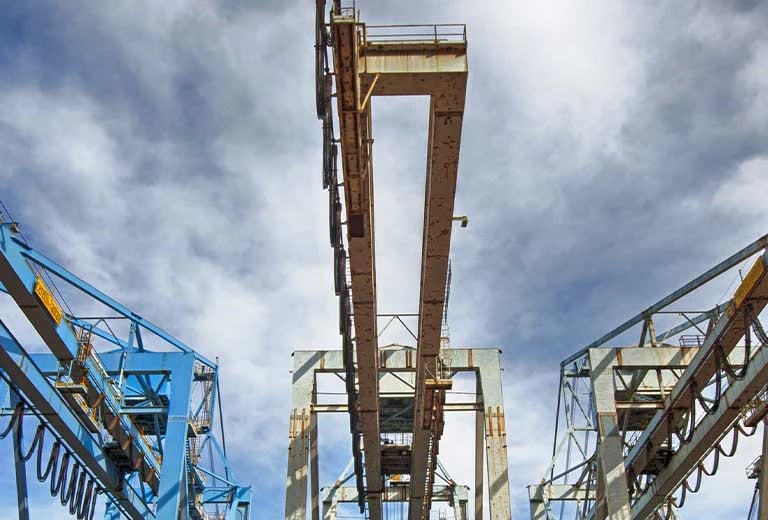

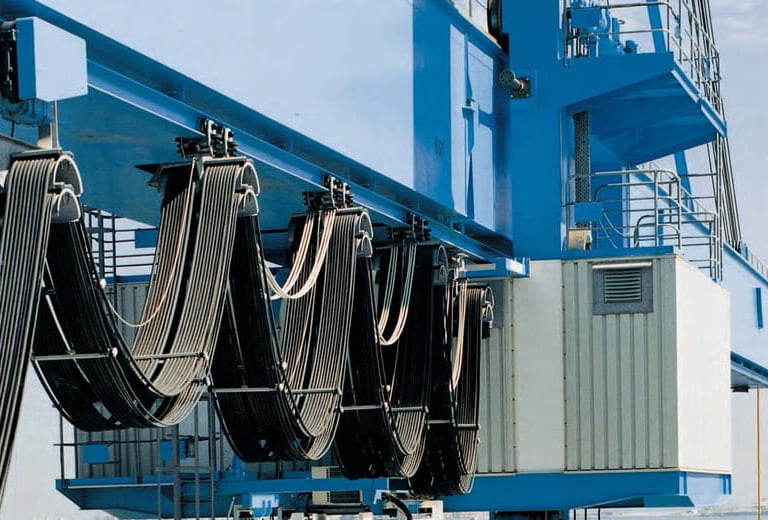

Conclusion
The (N)3GRDC5G-J/O flexible round festoon cables represent the pinnacle of industrial cable engineering, specifically designed to meet the demanding requirements of high mechanical stress applications. Their comprehensive feature set, including UV resistance, oil resistance, and exceptional mechanical properties, makes them the ideal choice for trolley systems, drag chains, conveyor facilities, and numerous other industrial applications.
The combination of advanced materials, rigorous testing, and compliance with international standards ensures that these cables deliver reliable performance in the most challenging environments. For Australian industrial operators seeking cable solutions that provide long-term reliability, operational efficiency, and regulatory compliance, the (N)3GRDC5G-J/O festoon cables offer an unmatched solution.
Selecting the right cable for high mechanical stress applications is crucial for operational success. The (N)3GRDC5G-J/O festoon cables provide the durability, versatility, and reliability required to maintain productive operations whilst minimising maintenance requirements and maximising return on investment.
Frequently Asked Questions
Q: What makes (N)3GRDC5G-J/O cables suitable for outdoor applications? A: These cables feature heavy-duty rubber outer sheath with UV, ozone, and moisture resistance, combined with weather-resistant materials throughout the construction. They operate reliably in temperature ranges from -30°C to 80°C for flexible applications.
Q: How do these cables perform in oil-contaminated environments? A: The cables are tested for oil resistance according to DIN EN/IEC 60811-404 standards, ensuring the insulation and sheath materials maintain their properties when exposed to industrial oils and lubricants.
Q: What is the minimum bending radius for festoon applications? A: For festoon applications, the minimum bending radius is 5 times the outer diameter of the cable. This specification ensures longevity under frequent bending cycles typical in festoon systems.
Q: Are these cables suitable for drag chain applications? A: Yes, the (N)3GRDC5G-J/O cables are specifically designed for drag chain applications, with construction optimised for continuous flexing and mechanical stress typical in cable carrier systems.
Q: What voltage ratings do these cables support? A: The cables are rated at 0.6/1kV (U0/U) with maximum permissible operating voltage of 0.7/1.2kV in AC systems, suitable for both power and control applications.
Q: How do these cables comply with Australian industrial standards? A: The cables meet RoHS 2015/863/EU, LVD 2014/35/EU, and CPR 305/2011 compliance requirements, ensuring compatibility with Australian industrial standards and international specifications.
Q: What conductor specifications do these cables feature? A: The cables use bare copper conductors with Class 5 fine stranding according to DIN EN/IEC 60228, providing excellent flexibility and electrical conductivity for dynamic applications.
How to Reach Us
Get in Touch
SiteMap
Product Catalogue
Reeling Cable
Festoon Cable
Shore Power Cable




Scan to add us on WeChat
